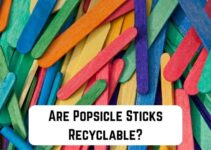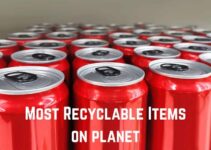Popular building materials like particle board are often utilized to create flooring, cabinets, and furniture. With the aid of a resin binder, sawdust, wood chips, and other wood waste are compressed to create it.
Particle board is a durable and reasonably priced material, although it is only sometimes apparent if it can be recycled. Can particle board be recycled? We will address this in this article and some general recycling information.
What is Particle Board?
The engineered wood product known as particle board, frequently called low-viscosity fiberboard or chipboard, is created by pressing and banishing wood chips with synthetic resin or other suitable binders.
Straight strand board, a different kind of fiberboard that employs machined wood flakes and provides additional strength, is frequently confused with particle board.
When the economy is more essential than durability and appearance, particle board is replaced by plywood and conventional wood since it is less expensive, denser, and more uniform.
Painting or applying wood veneer to visible particleboard surfaces might improve its appearance. Since it exclusively uses wood waste, particle board is a tree-based product that does not increase deforestation.
Reusing wood chips, particles, and sawdust gathered from sawmills is made very easy with the help of engineered wood. However, the glue’s chemicals, which make the creation of these boards necessary, are a source of worry.
Particleboard has a significant drawback: it can expand and turn discolored when exposed to moisture, especially if paint or another sealant is not used to cover it.
Except for bathrooms, kitchens, and laundry rooms, where it is frequently used as an underlay shield behind a moisture-proof continuous sheet of vinyl flooring, it is rarely utilized outdoors or in locations with significant quantities of moisture.
Due to its stability, affordability, and ease, veneered particleboard is chosen over veneered plywood in dry conditions.
Can Particle Board Be Recycled?
You can recycle particle board. The recycling of particle boards is more complex than recycling other materials, such as paper or plastic. Particle boards must first be separated from any other materials, such as metal or plastic, that may adhere to them before recycling.
Both mechanical backing and physical labor are acceptable for this. After separation, the particle board is broken into pieces and combined with a resin binder to produce a new board.
The original particle board’s quality and the resin binder’s effectiveness determine the standard of the recycled particle board. Even while recycled particle board is not as sturdy or long-lasting as new ones, it can still be used in various ways.
The possibility of particle boards containing dangerous substances like formaldehyde makes recycling difficult. Particle board is frequently made with the resin binder formaldehyde. However, this substance is also known to cause cancer.
Formaldehyde, which poses a health concern to employees and the environment, may be discharged into the air during the recycling of particle boards. Some businesses have created formaldehyde-free resin binders to utilize in the manufacture of particle boards in order to address this problem.
These binders do not release hazardous chemicals if the board is recycled because they comprise natural resources like soybeans or maize. Recycling can be made safer and more environmentally friendly by using resin binders free of formaldehyde.
Particle boards may contain contaminants like paint or glue, which makes recycling difficult. The particle board can be difficult to recycle due to these impurities, and the quality of recycled content may suffer.
Particle boards and other building supplies should be disposed of correctly to prevent pollution.

Is Particle Board Waterproof?
Particle board should be kept inside for a short time because it is designed for indoor use. When the particle board is moist, it may swell and develop long-lasting deformation. Furthermore, particle boards can fade and degrade from exposure to sunshine over time.
When wet, a particle board’s structural integrity can be dramatically impacted by swelling and warping. This may happen due to environmental humidity changes or direct water exposure.
Wood fragments are used to make particle board, which is held together by an adhesive. The board may distort if the glue becomes moist because it may weaken, allowing the wood fibers to separate and move.
Additionally, the wood’s fibers may absorb moisture and swell, which could cause the board to bow or twist. Even particle board coated with a water-resistant sealer is susceptible to this.
The particle board can become fragile due to all of this, making it incapable of bearing weight. It is not recommended to get particleboard damp because it is made of wood and other components.
In order to avoid warping or deterioration, it ought to be dried out as quickly as it gets wet. Particleboard can be subjected to moisture for different lengths of time, based on the quantity of moisture and the kind of particleboard.
Particleboard should be submerged in water for a maximum of a few hours. The particleboard can become bent, bloated, and destroyed if it is exposed to dampness for over an hour or two.
The water should be removed as quickly as possible, and the damaged parts should be completely dried off to return the particleboard to its former state. It could be required to replace the board if sufficient time has passed and it is still moist.
Is Particle Board Biodegradable?
Due to synthetic adhesives, the particle board lacks a carbon offset value and is not biodegradable. The sustainability of particle boards depends on the wood and glue that make up their parts. Utilizing wood waste is sustainable due to timber trees’ ability to absorb carbon.
If producers use eco-friendly materials and customers recycle particle board products effectively, LDF panels could be produced and consumed sustainably. Because timber trees have the potential to store carbon, wood is generally a sustainable material.
Moreover, the material’s environmental advantages are increased when wood waste is used. Although the majority of glues involve hazardous chemicals, there are organic bonding options that are better for the environment.
Alternatives To Particle Board
Even though particle board is among the best materials for basic construction and furniture because of its toughness and durability for such a low-cost material, some alternatives have comparable qualities at a comparable price.
EKO Ply
Eko Ply is substantially more resilient and durable than plywood and is water-resistant, rot- and corrosion-resistant. Due to its chemical resistance, EKO Ply does not distort, degrade, or lose its rigidity when used with adhesives, paint, and the like.
This makes EKO Ply a material suited for long-term outdoor buildings and simple to clean and maintain. Like many plywood substitutes, EKO Ply lacks aesthetic appeal due to its grey hue and pockets of different colors dotted all over the material.
As a result, it might be good on its own in locations where you have no issue with the material’s visual appeal.
Medium Density Fiberboard
Medium Density Fiberboard (MDF), an engineered wood product constructed from wood fibers rather than recycled wood particles, is of higher quality than particleboard. Among the most well-liked and frequently utilized plywood substitutes is MDF.
Despite often costing more than plywood, MDF has a few significant benefits. Since MDF does not expand or contract in response to changes in weather, it provides additional structural security. MDF is held together with environmentally acceptable chemicals.
Oriented Strand Board
In order to give it a consistent appearance and durable structure, scraped wood materials are arranged, processed, and combined to create an Oriented Strand Board. Different sizes, strengths, rigidities, and thicknesses of OSB are available.
This makes it a flexible plywood substitute that is more water-resistant and warping-resistant than plywood. It is also a renewable resource, constructed from strips of quickly growing trees and recycled scrap wood.
Polyurethane Board
As polyurethane is a polymer, it represents the biggest departure from plywood alternatives on our list. Since polyurethane board comprises plastic, it can have either a rough or smooth feel based on how it was produced.
Its ability to withstand water, its propensity to neither retain nor attract moisture, and the simplicity with which adhesives can be used for it are some physical characteristics of plastic that make it a better choice for plywood.
Plywood and polyurethane boards both have quality of being an incredibly light material with surprising durability. Additionally, adding fiberglass-reinforced polyurethane board at a greater cost greatly increases its longevity.
How to Dispose of Particle Board?
It makes sense that MDF particle board, commonly used for cabinetry and window and door trim in modern homes, will eventually need to be removed. However, how do you get rid of it?
As long as your town permits it, you can quickly snap trim into little pieces and toss it in the usual garbage run since MDF is so brittle. Although large MDF panels are more difficult to break, they will give way when struck with a sledgehammer.
Particleboard is one of the recyclables that some cities accept for their recycling programs. With nearly 83 percent of the particleboard being created from completely recycled material, certain newer forms of particleboard are the product of this almost finished recycling loop.
Conclusion
Particle board recycling has been difficult for a long time. The fundamental problem is that the wood fibers cannot be easily separated from the resin adhesive used to bind the wood particles together.
Thanks to recent technological developments, particle boards may now be recycled more effectively. Enzymes are one such technique that can be used to dissolve resin adhesives. Biochemical catalysts called enzymes can disassemble complicated compounds into simpler ones.






